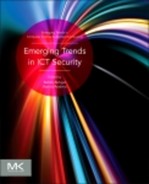Table of Contents
Part 1: Information and Systems Security
Chapter 1. System Security Engineering for Information Systems
System security engineering history
Established system security engineering methods, processes, and tools
Modern and emerging system security engineering methods, processes, and tools
Chapter 2. Metrics and Indicators as Key Organizational Assets for ICT Security Assessment
Security evaluation for a web system: A proof of concept
A sketch of ontological semantic technology
UML extensions for XML security
Extensions for policy modeling and integration
Integrating local security policies into a global security policy
Chapter 5. Gamification of Information Security Awareness Training
Chapter 6. A Conceptual Framework for Information Security Awareness, Assessment, and Training
Human factors and information security
Information security learning continuum
Dimensions of information security awareness
Chapter 7. Security Projects for Systems and Networking Professionals
Chapter 8. Assessing the Role of Governments in Securing E-Business: The Case of Jordan
Security in Jordan’s E-business initiatives: An analysis
Conclusion and recommendations
Part 2: Network and Infrastructure Security
Chapter 9. A Survey of Quantum Key Distribution (QKD) Technologies
Quantum key distribution systems
Chapter 10. Advances in Self-Security of Agent-Based Intrusion Detection Systems
Framework for self-security, self-reliability and self-integrity of agent-based IDSs
Prototyping and extending IDS-NIDIA
Chapter 11. Secure Communication in Fiber-Optic Networks
Privacy and optical steganography
Chapter 12. Advanced Security Network Metrics
Chapter 13. Designing Trustworthy Software Systems Using the NFR Approach
The Phoenix system and trustworthiness deficit
Application of the NFR approach for designing a trustworthy Phoenix system
Validation and lessons learned
Secure cooperative wireless communications
Chapter 15. Algebraic Approaches to a Network-Type Private Information Retrieval
The data processing scheme and statement of the problem
Algorithmic description of the solution
Algebraic description of the solution
Chapter 16. Using Event Reasoning for Trajectory Tracking
Event functions and inference rules
Chapter 17. Resource-Efficient Multi-Source Authentication Utilizing Split-Join One-Way Key Chain
Chapter 18. Real-time Network Intrusion Detection Using Hadoop-Based Bayesian Classifier
Overview on Hadoop based technologies
Survey of Intrusion Detection Systems
Hadoop-based real-time Intrusion Detection: System architecture
Practical application scenario and system evaluation
Chapter 19. Optimum Countermeasure Portfolio Selection: A Knapsack Approach
The Knapsack problem and a dynamic programming solution
The proposed binary knapsack-based approach and its dynamic programming algorithm
Computational example and comparison
Chapter 20. CSRF and Big Data: Rethinking Cross-Site Request Forgery in Light of Big Data
Defenses against CSRF: Server and browser Sides
Experiment results: CSRF in social media and networking sites
Analysis of test framework with popular Web/URL scanning tools
Chapter 21. Security through Emulation-Based Processor Diversification
Chapter 22. On the Use of Unsupervised Techniques for Fraud Detection in VoIP Networks
Signature-based fraud detection
Part 3: Mobile and Cloud Computing
Provisioned access control infrastructure (DACI)
Chapter 24. Detection of Intent-Based Vulnerabilities in Android Applications
Model definition and notations
Implementation and experimentation
Part 4: Cyber Crime and Cyber Terrorism
Chapter 25. A Quick Perspective on the Current State in Cybersecurity
Understanding the scope of cybersecurity
Malware, the infectious disease, and phishing, the fraud
Vulnerabilities: The long exploitable holes
Data breach: A faulty containment
Cyber-war, the latest war front
Chapter 26. A Paradigm Shift in Cyberspace Security
A security paradigm shift in cyberspace
Intelligent agents in security auditing
Chapter 27. Counter Cyber Attacks By Semantic Networks
Chapter 28. Man-in-the-Browser Attacks in Modern Web Browsers
Man-in-the-browser attacks on different layers
Chapter 29. Improving Security in Web Sessions: Special Management of Cookies
Proposed mechanism for web session management
Implementation and experiments
Chapter 30. Leveraging Semantic Web Technologies for Access Control
Implementing RBAC with ontologies
Semantically extending the XACML attribute model
Ontology-based context awareness
Ontological specification of user preferences
Semantic access control in online social networks
DEMONS ontological access control model
Chapter 31. Cyber Security Education: The Merits of Firewall Exercises
Criteria for firewall education
Evaluation of firewall exercises
Emerging trends in firewall education
Chapter 32. Surveillance without Borders: The Case of Karen Refugees in Sheffield
“We are Watching You”: Analysis of discourse messages posted
Part 5: Focus Topics: From Online Radicalisation to Online Financial Crime
Systematic consideration of influencing factors: The radicalization-factor model
Identification of radicalized individuals: Behavioral indicators
Collaboration in counter-terrorism
Chapter 35. Investigating Radicalized Individual Profiles through Fuzzy Cognitive Maps
The radicalization process: How can it happen?
Investigating radical online profiles: A short overview of existing methods
Fuzzy cognitive mapping of factors for self-radicalization as an alternative approach
Chapter 36. Financial Security against Money Laundering: A Survey
Data mining techniques for ML detection
Chapter 37. Intelligent Banking XML Encryption Using Effective Fuzzy Logic
